The Health Professional in a Global Environment: Roles and Literacies
VerifiedAdded on 2023/06/13
|10
|2834
|275
Essay
AI Summary
This essay discusses the role of a health professional in a global environment, highlighting the importance of cultural sensitivity, collaboration, and understanding diverse patient conditions. It emphasizes the significance of therapeutic relationships in patient care, discussing how factors like age, race, and social background influence these relationships. The essay also explores verbal and non-verbal communication strategies, such as reflection, exploration, and clarification, that are crucial for establishing and maintaining effective communication with patients. The importance of good interpersonal skills in reducing medical errors and overcoming social and cultural barriers is also discussed. The essay concludes that global health professionals need adequate skills and competencies to thrive in diverse settings, ultimately improving healthcare outcomes and professional satisfaction. Desklib offers a wide range of resources for students, including solved assignments and past papers.

Name 1
Being a health professional
Student’s name
University
Lecturer
Date
Being a health professional
Student’s name
University
Lecturer
Date
Paraphrase This Document
Need a fresh take? Get an instant paraphrase of this document with our AI Paraphraser
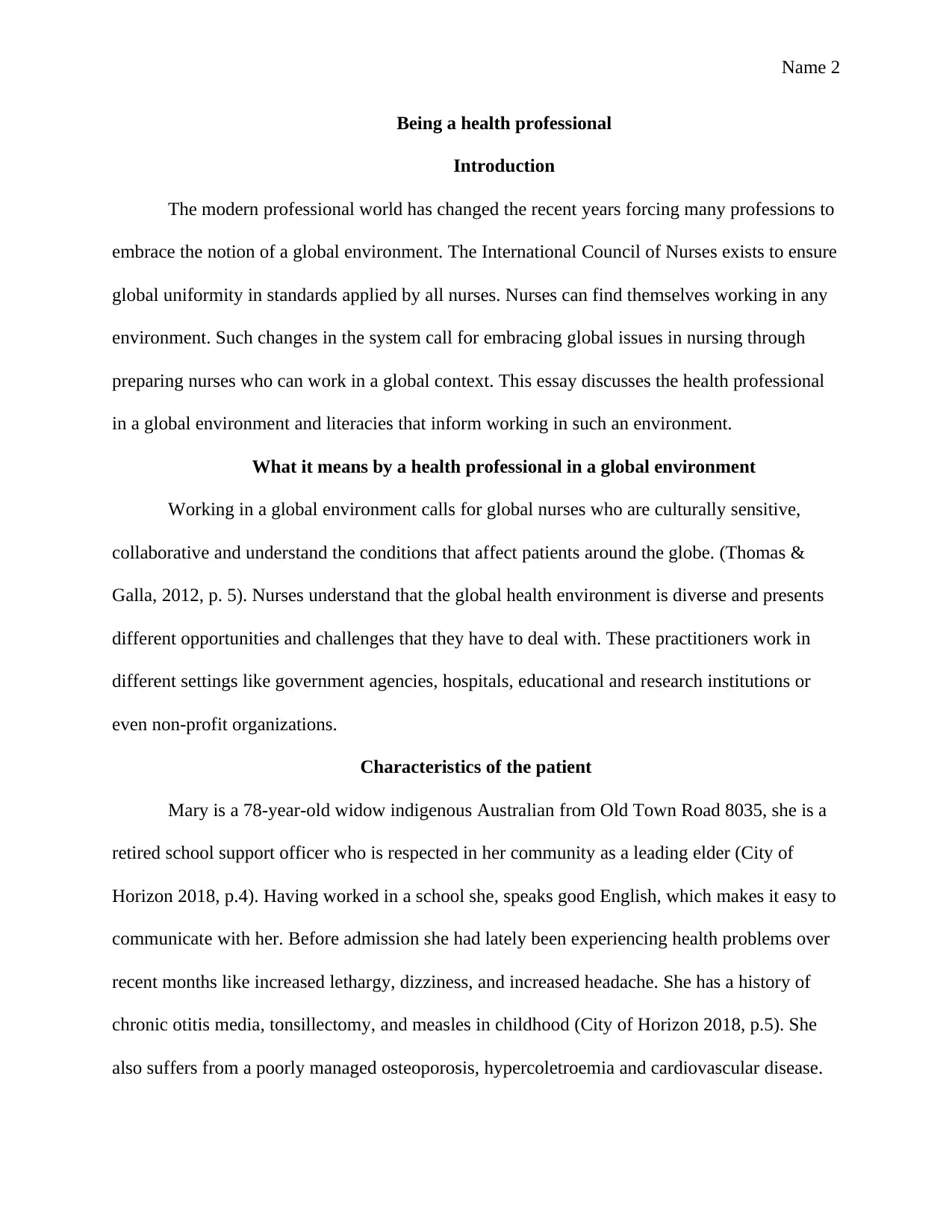
Name 2
Being a health professional
Introduction
The modern professional world has changed the recent years forcing many professions to
embrace the notion of a global environment. The International Council of Nurses exists to ensure
global uniformity in standards applied by all nurses. Nurses can find themselves working in any
environment. Such changes in the system call for embracing global issues in nursing through
preparing nurses who can work in a global context. This essay discusses the health professional
in a global environment and literacies that inform working in such an environment.
What it means by a health professional in a global environment
Working in a global environment calls for global nurses who are culturally sensitive,
collaborative and understand the conditions that affect patients around the globe. (Thomas &
Galla, 2012, p. 5). Nurses understand that the global health environment is diverse and presents
different opportunities and challenges that they have to deal with. These practitioners work in
different settings like government agencies, hospitals, educational and research institutions or
even non-profit organizations.
Characteristics of the patient
Mary is a 78-year-old widow indigenous Australian from Old Town Road 8035, she is a
retired school support officer who is respected in her community as a leading elder (City of
Horizon 2018, p.4). Having worked in a school she, speaks good English, which makes it easy to
communicate with her. Before admission she had lately been experiencing health problems over
recent months like increased lethargy, dizziness, and increased headache. She has a history of
chronic otitis media, tonsillectomy, and measles in childhood (City of Horizon 2018, p.5). She
also suffers from a poorly managed osteoporosis, hypercoletroemia and cardiovascular disease.
Being a health professional
Introduction
The modern professional world has changed the recent years forcing many professions to
embrace the notion of a global environment. The International Council of Nurses exists to ensure
global uniformity in standards applied by all nurses. Nurses can find themselves working in any
environment. Such changes in the system call for embracing global issues in nursing through
preparing nurses who can work in a global context. This essay discusses the health professional
in a global environment and literacies that inform working in such an environment.
What it means by a health professional in a global environment
Working in a global environment calls for global nurses who are culturally sensitive,
collaborative and understand the conditions that affect patients around the globe. (Thomas &
Galla, 2012, p. 5). Nurses understand that the global health environment is diverse and presents
different opportunities and challenges that they have to deal with. These practitioners work in
different settings like government agencies, hospitals, educational and research institutions or
even non-profit organizations.
Characteristics of the patient
Mary is a 78-year-old widow indigenous Australian from Old Town Road 8035, she is a
retired school support officer who is respected in her community as a leading elder (City of
Horizon 2018, p.4). Having worked in a school she, speaks good English, which makes it easy to
communicate with her. Before admission she had lately been experiencing health problems over
recent months like increased lethargy, dizziness, and increased headache. She has a history of
chronic otitis media, tonsillectomy, and measles in childhood (City of Horizon 2018, p.5). She
also suffers from a poorly managed osteoporosis, hypercoletroemia and cardiovascular disease.
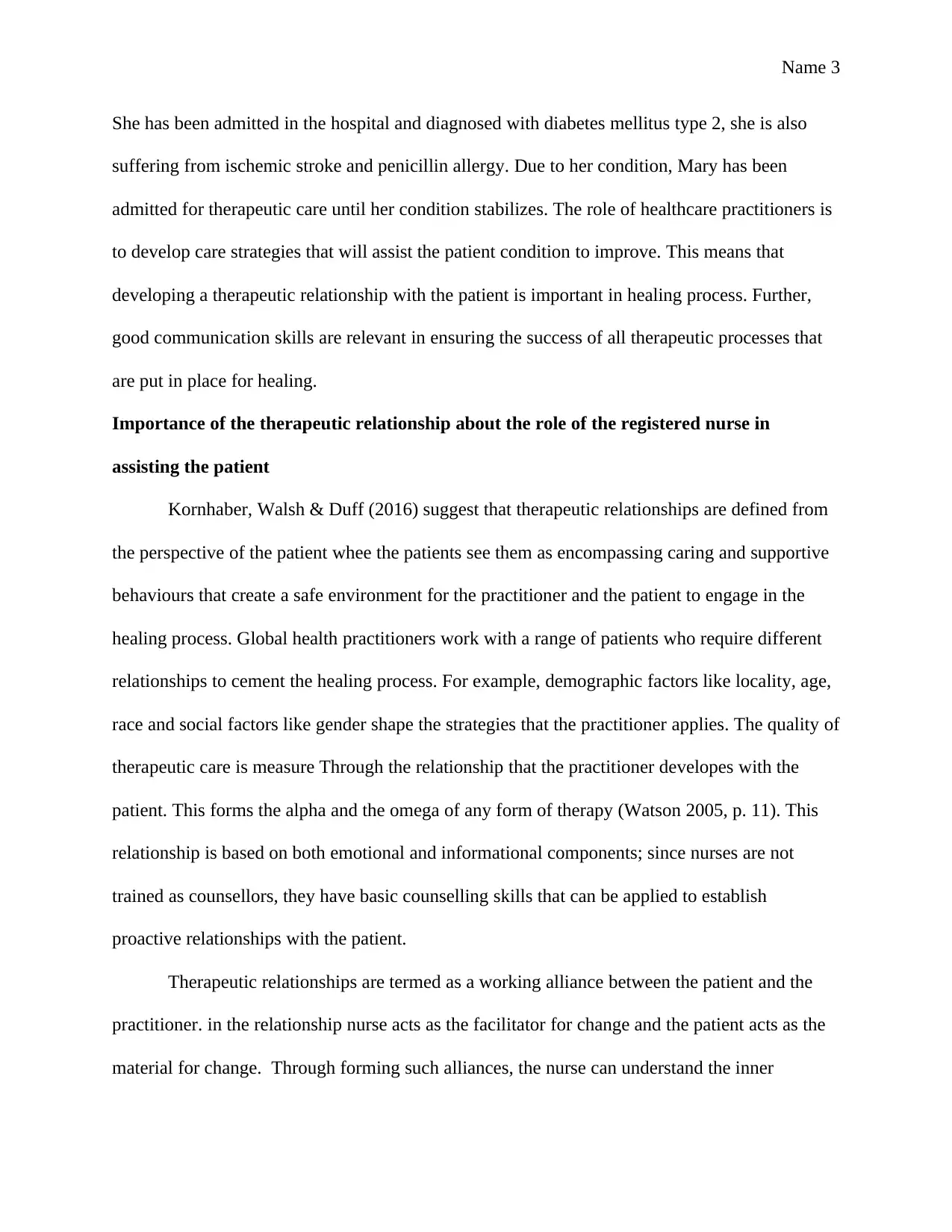
Name 3
She has been admitted in the hospital and diagnosed with diabetes mellitus type 2, she is also
suffering from ischemic stroke and penicillin allergy. Due to her condition, Mary has been
admitted for therapeutic care until her condition stabilizes. The role of healthcare practitioners is
to develop care strategies that will assist the patient condition to improve. This means that
developing a therapeutic relationship with the patient is important in healing process. Further,
good communication skills are relevant in ensuring the success of all therapeutic processes that
are put in place for healing.
Importance of the therapeutic relationship about the role of the registered nurse in
assisting the patient
Kornhaber, Walsh & Duff (2016) suggest that therapeutic relationships are defined from
the perspective of the patient whee the patients see them as encompassing caring and supportive
behaviours that create a safe environment for the practitioner and the patient to engage in the
healing process. Global health practitioners work with a range of patients who require different
relationships to cement the healing process. For example, demographic factors like locality, age,
race and social factors like gender shape the strategies that the practitioner applies. The quality of
therapeutic care is measure Through the relationship that the practitioner developes with the
patient. This forms the alpha and the omega of any form of therapy (Watson 2005, p. 11). This
relationship is based on both emotional and informational components; since nurses are not
trained as counsellors, they have basic counselling skills that can be applied to establish
proactive relationships with the patient.
Therapeutic relationships are termed as a working alliance between the patient and the
practitioner. in the relationship nurse acts as the facilitator for change and the patient acts as the
material for change. Through forming such alliances, the nurse can understand the inner
She has been admitted in the hospital and diagnosed with diabetes mellitus type 2, she is also
suffering from ischemic stroke and penicillin allergy. Due to her condition, Mary has been
admitted for therapeutic care until her condition stabilizes. The role of healthcare practitioners is
to develop care strategies that will assist the patient condition to improve. This means that
developing a therapeutic relationship with the patient is important in healing process. Further,
good communication skills are relevant in ensuring the success of all therapeutic processes that
are put in place for healing.
Importance of the therapeutic relationship about the role of the registered nurse in
assisting the patient
Kornhaber, Walsh & Duff (2016) suggest that therapeutic relationships are defined from
the perspective of the patient whee the patients see them as encompassing caring and supportive
behaviours that create a safe environment for the practitioner and the patient to engage in the
healing process. Global health practitioners work with a range of patients who require different
relationships to cement the healing process. For example, demographic factors like locality, age,
race and social factors like gender shape the strategies that the practitioner applies. The quality of
therapeutic care is measure Through the relationship that the practitioner developes with the
patient. This forms the alpha and the omega of any form of therapy (Watson 2005, p. 11). This
relationship is based on both emotional and informational components; since nurses are not
trained as counsellors, they have basic counselling skills that can be applied to establish
proactive relationships with the patient.
Therapeutic relationships are termed as a working alliance between the patient and the
practitioner. in the relationship nurse acts as the facilitator for change and the patient acts as the
material for change. Through forming such alliances, the nurse can understand the inner
⊘ This is a preview!⊘
Do you want full access?
Subscribe today to unlock all pages.

Trusted by 1+ million students worldwide

Name 4
anxieties and disturbances that patients face which may hinder the overall healing process of the
patient. According to Jung, the therapist needs to see the client as an equal, thus there is need to
abandon the preconceived opinions that exist in healthcare setting and approach each situation
independently (Wilde McCormick & Wellings, 2000, p. 16). The relationship allows the nurse to
creates a comfortable and non-judgemental environment Through demonstrated congruence and
unconditional positive regard towards patients thus improving the healing process. In this
scenario patients like Mary will feel that the nurse is on their side Through showing respect for
her inner and outer life.
Further, Through proper communication skills the nurse can develop trust and build
rapport with the patient which allows them to open up on issues affecting them. In the
therapeutic process, the nurse and the patient communicate where the patient is supposed to
report progress and any changes in the body system or new symptoms that are felt. Once the
nurse has established such relationships, it becomes easy for the patient to open up making it
easy for the practitioner to track the changes in medication of the patient (Kilduff, 2010, p. 241).
This process therefore, decreases anxiety and enhance patient compliance with the therapeutic
process which in turn leads to improved healthcare outcomes. The nurse can easily achieve
clinical goals like awareness of the problem since the patient easily opens up allowing the
practitioner to identify most concerns needed by the patient. Since background history is an
important element in the clinical process, some patients can exhibit barriers if they are not
comfortable with the practitioner around them (Castledine, 2013, p. 15). Through
communication, the nurse creates an environment that allows the patient to open up and allow
collection of relevant information that guides the progress of therapeutic processes.
anxieties and disturbances that patients face which may hinder the overall healing process of the
patient. According to Jung, the therapist needs to see the client as an equal, thus there is need to
abandon the preconceived opinions that exist in healthcare setting and approach each situation
independently (Wilde McCormick & Wellings, 2000, p. 16). The relationship allows the nurse to
creates a comfortable and non-judgemental environment Through demonstrated congruence and
unconditional positive regard towards patients thus improving the healing process. In this
scenario patients like Mary will feel that the nurse is on their side Through showing respect for
her inner and outer life.
Further, Through proper communication skills the nurse can develop trust and build
rapport with the patient which allows them to open up on issues affecting them. In the
therapeutic process, the nurse and the patient communicate where the patient is supposed to
report progress and any changes in the body system or new symptoms that are felt. Once the
nurse has established such relationships, it becomes easy for the patient to open up making it
easy for the practitioner to track the changes in medication of the patient (Kilduff, 2010, p. 241).
This process therefore, decreases anxiety and enhance patient compliance with the therapeutic
process which in turn leads to improved healthcare outcomes. The nurse can easily achieve
clinical goals like awareness of the problem since the patient easily opens up allowing the
practitioner to identify most concerns needed by the patient. Since background history is an
important element in the clinical process, some patients can exhibit barriers if they are not
comfortable with the practitioner around them (Castledine, 2013, p. 15). Through
communication, the nurse creates an environment that allows the patient to open up and allow
collection of relevant information that guides the progress of therapeutic processes.
Paraphrase This Document
Need a fresh take? Get an instant paraphrase of this document with our AI Paraphraser
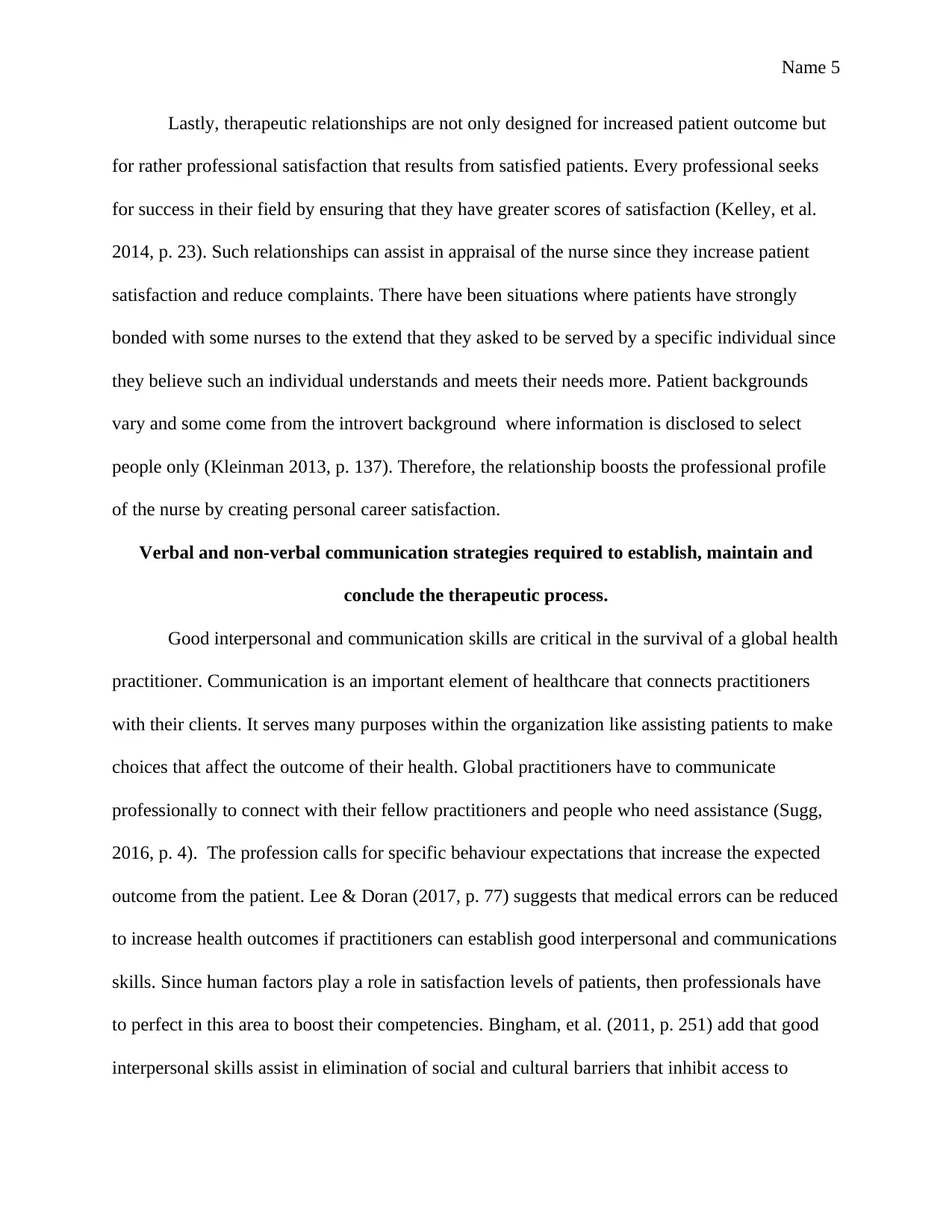
Name 5
Lastly, therapeutic relationships are not only designed for increased patient outcome but
for rather professional satisfaction that results from satisfied patients. Every professional seeks
for success in their field by ensuring that they have greater scores of satisfaction (Kelley, et al.
2014, p. 23). Such relationships can assist in appraisal of the nurse since they increase patient
satisfaction and reduce complaints. There have been situations where patients have strongly
bonded with some nurses to the extend that they asked to be served by a specific individual since
they believe such an individual understands and meets their needs more. Patient backgrounds
vary and some come from the introvert background where information is disclosed to select
people only (Kleinman 2013, p. 137). Therefore, the relationship boosts the professional profile
of the nurse by creating personal career satisfaction.
Verbal and non-verbal communication strategies required to establish, maintain and
conclude the therapeutic process.
Good interpersonal and communication skills are critical in the survival of a global health
practitioner. Communication is an important element of healthcare that connects practitioners
with their clients. It serves many purposes within the organization like assisting patients to make
choices that affect the outcome of their health. Global practitioners have to communicate
professionally to connect with their fellow practitioners and people who need assistance (Sugg,
2016, p. 4). The profession calls for specific behaviour expectations that increase the expected
outcome from the patient. Lee & Doran (2017, p. 77) suggests that medical errors can be reduced
to increase health outcomes if practitioners can establish good interpersonal and communications
skills. Since human factors play a role in satisfaction levels of patients, then professionals have
to perfect in this area to boost their competencies. Bingham, et al. (2011, p. 251) add that good
interpersonal skills assist in elimination of social and cultural barriers that inhibit access to
Lastly, therapeutic relationships are not only designed for increased patient outcome but
for rather professional satisfaction that results from satisfied patients. Every professional seeks
for success in their field by ensuring that they have greater scores of satisfaction (Kelley, et al.
2014, p. 23). Such relationships can assist in appraisal of the nurse since they increase patient
satisfaction and reduce complaints. There have been situations where patients have strongly
bonded with some nurses to the extend that they asked to be served by a specific individual since
they believe such an individual understands and meets their needs more. Patient backgrounds
vary and some come from the introvert background where information is disclosed to select
people only (Kleinman 2013, p. 137). Therefore, the relationship boosts the professional profile
of the nurse by creating personal career satisfaction.
Verbal and non-verbal communication strategies required to establish, maintain and
conclude the therapeutic process.
Good interpersonal and communication skills are critical in the survival of a global health
practitioner. Communication is an important element of healthcare that connects practitioners
with their clients. It serves many purposes within the organization like assisting patients to make
choices that affect the outcome of their health. Global practitioners have to communicate
professionally to connect with their fellow practitioners and people who need assistance (Sugg,
2016, p. 4). The profession calls for specific behaviour expectations that increase the expected
outcome from the patient. Lee & Doran (2017, p. 77) suggests that medical errors can be reduced
to increase health outcomes if practitioners can establish good interpersonal and communications
skills. Since human factors play a role in satisfaction levels of patients, then professionals have
to perfect in this area to boost their competencies. Bingham, et al. (2011, p. 251) add that good
interpersonal skills assist in elimination of social and cultural barriers that inhibit access to
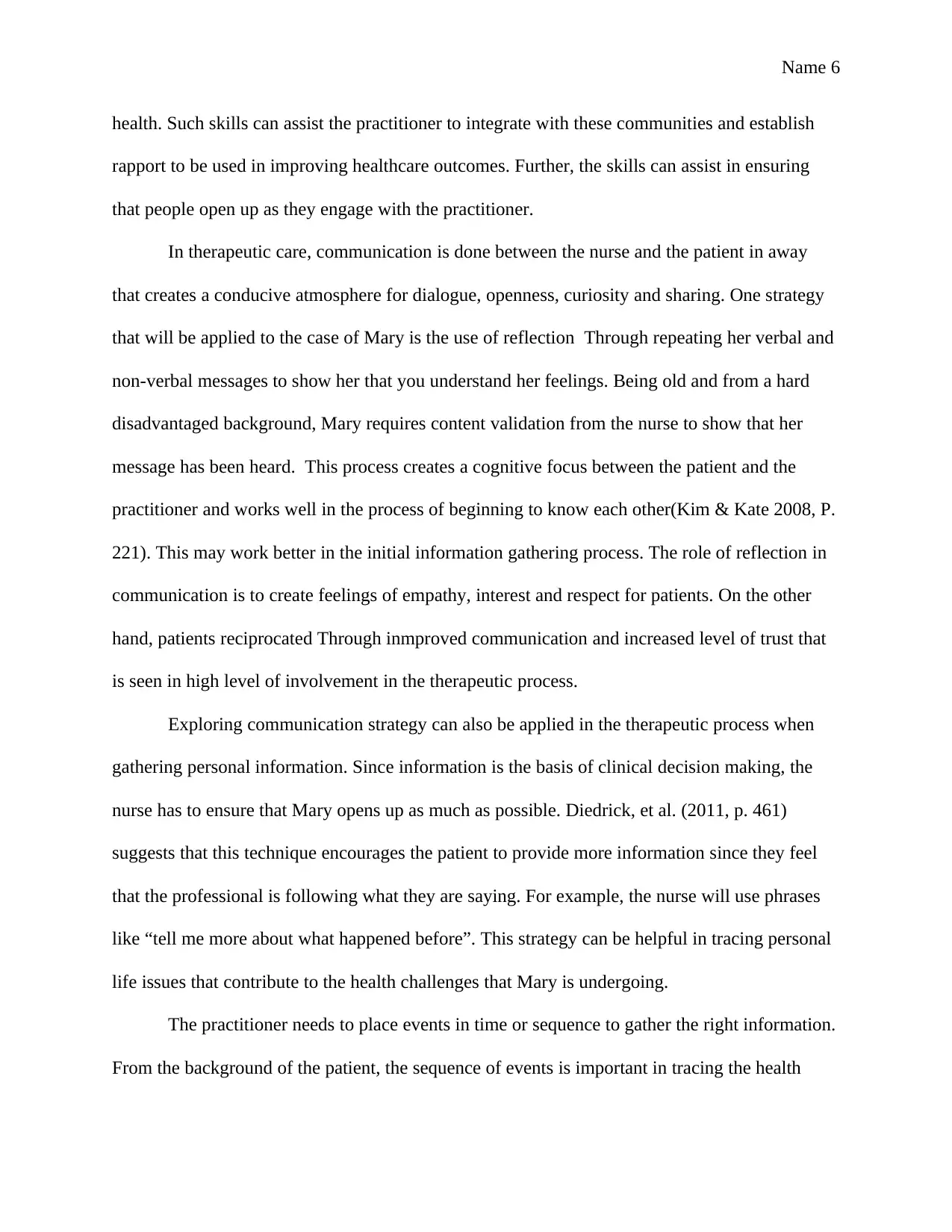
Name 6
health. Such skills can assist the practitioner to integrate with these communities and establish
rapport to be used in improving healthcare outcomes. Further, the skills can assist in ensuring
that people open up as they engage with the practitioner.
In therapeutic care, communication is done between the nurse and the patient in away
that creates a conducive atmosphere for dialogue, openness, curiosity and sharing. One strategy
that will be applied to the case of Mary is the use of reflection Through repeating her verbal and
non-verbal messages to show her that you understand her feelings. Being old and from a hard
disadvantaged background, Mary requires content validation from the nurse to show that her
message has been heard. This process creates a cognitive focus between the patient and the
practitioner and works well in the process of beginning to know each other(Kim & Kate 2008, P.
221). This may work better in the initial information gathering process. The role of reflection in
communication is to create feelings of empathy, interest and respect for patients. On the other
hand, patients reciprocated Through inmproved communication and increased level of trust that
is seen in high level of involvement in the therapeutic process.
Exploring communication strategy can also be applied in the therapeutic process when
gathering personal information. Since information is the basis of clinical decision making, the
nurse has to ensure that Mary opens up as much as possible. Diedrick, et al. (2011, p. 461)
suggests that this technique encourages the patient to provide more information since they feel
that the professional is following what they are saying. For example, the nurse will use phrases
like “tell me more about what happened before”. This strategy can be helpful in tracing personal
life issues that contribute to the health challenges that Mary is undergoing.
The practitioner needs to place events in time or sequence to gather the right information.
From the background of the patient, the sequence of events is important in tracing the health
health. Such skills can assist the practitioner to integrate with these communities and establish
rapport to be used in improving healthcare outcomes. Further, the skills can assist in ensuring
that people open up as they engage with the practitioner.
In therapeutic care, communication is done between the nurse and the patient in away
that creates a conducive atmosphere for dialogue, openness, curiosity and sharing. One strategy
that will be applied to the case of Mary is the use of reflection Through repeating her verbal and
non-verbal messages to show her that you understand her feelings. Being old and from a hard
disadvantaged background, Mary requires content validation from the nurse to show that her
message has been heard. This process creates a cognitive focus between the patient and the
practitioner and works well in the process of beginning to know each other(Kim & Kate 2008, P.
221). This may work better in the initial information gathering process. The role of reflection in
communication is to create feelings of empathy, interest and respect for patients. On the other
hand, patients reciprocated Through inmproved communication and increased level of trust that
is seen in high level of involvement in the therapeutic process.
Exploring communication strategy can also be applied in the therapeutic process when
gathering personal information. Since information is the basis of clinical decision making, the
nurse has to ensure that Mary opens up as much as possible. Diedrick, et al. (2011, p. 461)
suggests that this technique encourages the patient to provide more information since they feel
that the professional is following what they are saying. For example, the nurse will use phrases
like “tell me more about what happened before”. This strategy can be helpful in tracing personal
life issues that contribute to the health challenges that Mary is undergoing.
The practitioner needs to place events in time or sequence to gather the right information.
From the background of the patient, the sequence of events is important in tracing the health
⊘ This is a preview!⊘
Do you want full access?
Subscribe today to unlock all pages.

Trusted by 1+ million students worldwide
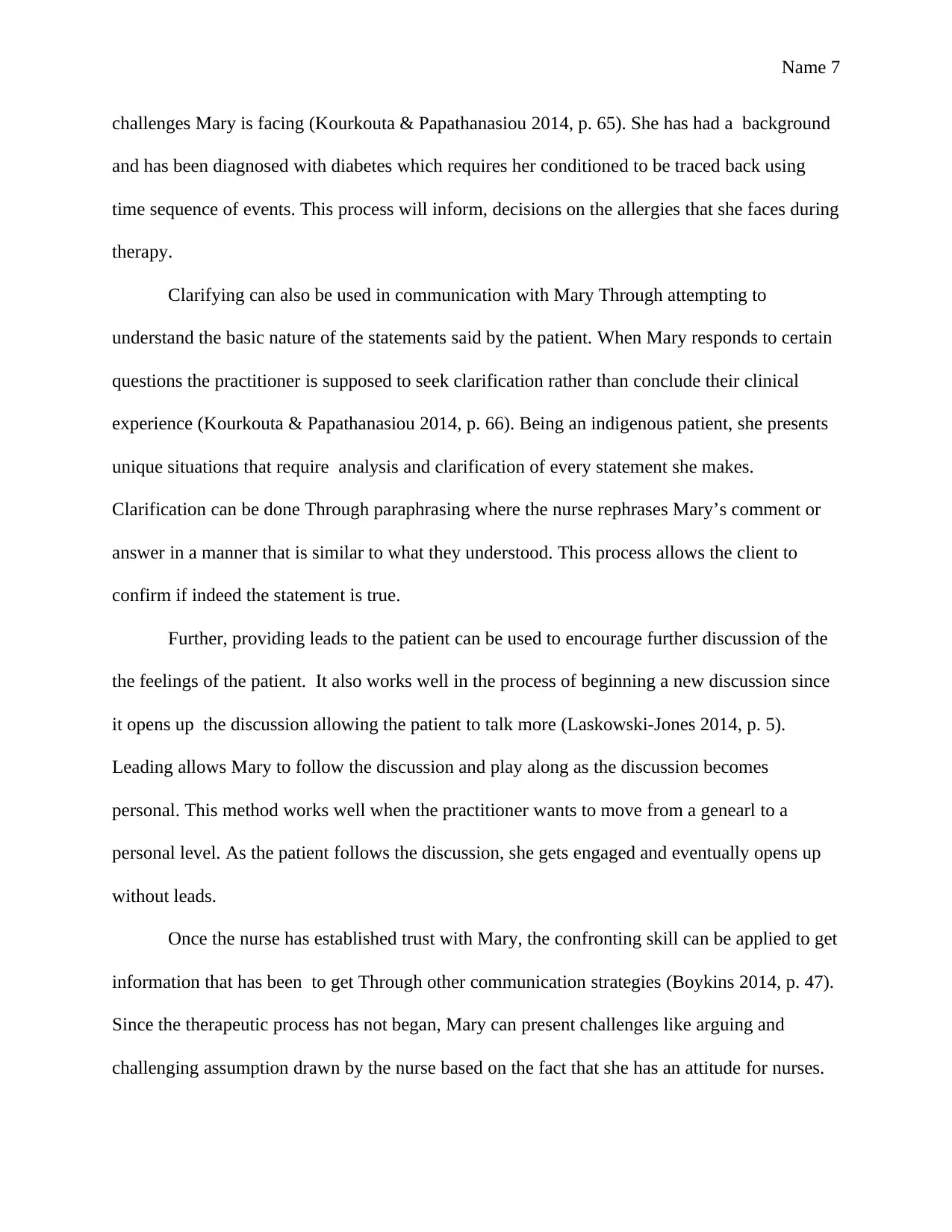
Name 7
challenges Mary is facing (Kourkouta & Papathanasiou 2014, p. 65). She has had a background
and has been diagnosed with diabetes which requires her conditioned to be traced back using
time sequence of events. This process will inform, decisions on the allergies that she faces during
therapy.
Clarifying can also be used in communication with Mary Through attempting to
understand the basic nature of the statements said by the patient. When Mary responds to certain
questions the practitioner is supposed to seek clarification rather than conclude their clinical
experience (Kourkouta & Papathanasiou 2014, p. 66). Being an indigenous patient, she presents
unique situations that require analysis and clarification of every statement she makes.
Clarification can be done Through paraphrasing where the nurse rephrases Mary’s comment or
answer in a manner that is similar to what they understood. This process allows the client to
confirm if indeed the statement is true.
Further, providing leads to the patient can be used to encourage further discussion of the
the feelings of the patient. It also works well in the process of beginning a new discussion since
it opens up the discussion allowing the patient to talk more (Laskowski-Jones 2014, p. 5).
Leading allows Mary to follow the discussion and play along as the discussion becomes
personal. This method works well when the practitioner wants to move from a genearl to a
personal level. As the patient follows the discussion, she gets engaged and eventually opens up
without leads.
Once the nurse has established trust with Mary, the confronting skill can be applied to get
information that has been to get Through other communication strategies (Boykins 2014, p. 47).
Since the therapeutic process has not began, Mary can present challenges like arguing and
challenging assumption drawn by the nurse based on the fact that she has an attitude for nurses.
challenges Mary is facing (Kourkouta & Papathanasiou 2014, p. 65). She has had a background
and has been diagnosed with diabetes which requires her conditioned to be traced back using
time sequence of events. This process will inform, decisions on the allergies that she faces during
therapy.
Clarifying can also be used in communication with Mary Through attempting to
understand the basic nature of the statements said by the patient. When Mary responds to certain
questions the practitioner is supposed to seek clarification rather than conclude their clinical
experience (Kourkouta & Papathanasiou 2014, p. 66). Being an indigenous patient, she presents
unique situations that require analysis and clarification of every statement she makes.
Clarification can be done Through paraphrasing where the nurse rephrases Mary’s comment or
answer in a manner that is similar to what they understood. This process allows the client to
confirm if indeed the statement is true.
Further, providing leads to the patient can be used to encourage further discussion of the
the feelings of the patient. It also works well in the process of beginning a new discussion since
it opens up the discussion allowing the patient to talk more (Laskowski-Jones 2014, p. 5).
Leading allows Mary to follow the discussion and play along as the discussion becomes
personal. This method works well when the practitioner wants to move from a genearl to a
personal level. As the patient follows the discussion, she gets engaged and eventually opens up
without leads.
Once the nurse has established trust with Mary, the confronting skill can be applied to get
information that has been to get Through other communication strategies (Boykins 2014, p. 47).
Since the therapeutic process has not began, Mary can present challenges like arguing and
challenging assumption drawn by the nurse based on the fact that she has an attitude for nurses.
Paraphrase This Document
Need a fresh take? Get an instant paraphrase of this document with our AI Paraphraser
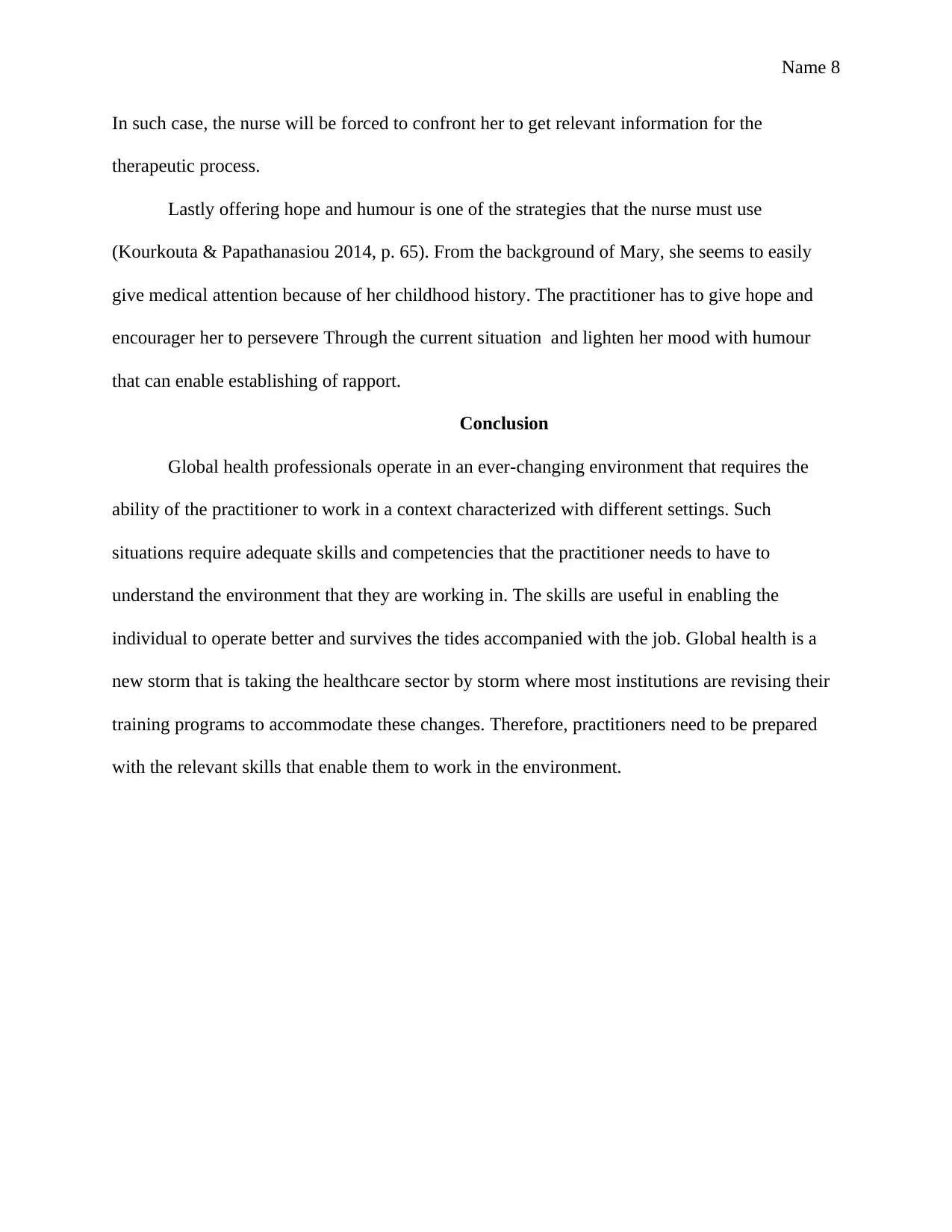
Name 8
In such case, the nurse will be forced to confront her to get relevant information for the
therapeutic process.
Lastly offering hope and humour is one of the strategies that the nurse must use
(Kourkouta & Papathanasiou 2014, p. 65). From the background of Mary, she seems to easily
give medical attention because of her childhood history. The practitioner has to give hope and
encourager her to persevere Through the current situation and lighten her mood with humour
that can enable establishing of rapport.
Conclusion
Global health professionals operate in an ever-changing environment that requires the
ability of the practitioner to work in a context characterized with different settings. Such
situations require adequate skills and competencies that the practitioner needs to have to
understand the environment that they are working in. The skills are useful in enabling the
individual to operate better and survives the tides accompanied with the job. Global health is a
new storm that is taking the healthcare sector by storm where most institutions are revising their
training programs to accommodate these changes. Therefore, practitioners need to be prepared
with the relevant skills that enable them to work in the environment.
In such case, the nurse will be forced to confront her to get relevant information for the
therapeutic process.
Lastly offering hope and humour is one of the strategies that the nurse must use
(Kourkouta & Papathanasiou 2014, p. 65). From the background of Mary, she seems to easily
give medical attention because of her childhood history. The practitioner has to give hope and
encourager her to persevere Through the current situation and lighten her mood with humour
that can enable establishing of rapport.
Conclusion
Global health professionals operate in an ever-changing environment that requires the
ability of the practitioner to work in a context characterized with different settings. Such
situations require adequate skills and competencies that the practitioner needs to have to
understand the environment that they are working in. The skills are useful in enabling the
individual to operate better and survives the tides accompanied with the job. Global health is a
new storm that is taking the healthcare sector by storm where most institutions are revising their
training programs to accommodate these changes. Therefore, practitioners need to be prepared
with the relevant skills that enable them to work in the environment.

Name 9
References
Bingham, A. et al., 2011. The Role of Interpersonal Communication in Preventing Unsafe
Abortion in Communities: The Dialogues for Life Project in Nepal. Journal of Health
Communication, 16(3), pp. 245-263.
Boykins, A., 2014. Core communication competencies in patient- centered care.. ABNF Journal,
25(2), pp. 40-45.
Castledine, G., 2013. The importance of the nurse-patient relationship. British Journal of
Nursing, 13(4), pp. 11-25.
City of Horizon 2018. City of Horizon 2018 ver.1.1, computer Program, city of Horizon, Novus
Res, Adelaide.. [Online].
Diedrick, L., Schaffer, M. & Sandau, K., 2011. A practical communication strategy to improve
implementation of evidence-based practice.. Journal of Nursing Administration, 41(11), pp. 459-
465.
Kelley, J. M. et al., 2014. The Influence of the Patient-Clinician Relationship on Healthcare
Outcomes: A Systematic Review and Meta-Analysis of Randomized Controlled Trials. PLoS
One, 9(4).
Kilduff M, T. W., 2010. Social Networks and Organizations. Sage ed. s.l.: Thousand Oaks,.
Kim, B. & Kate, W., 2008. How can health professionals enhance interpersonal communication
with adolescents and young adults to improve health care outcomes?: systematic literature
review. International Journal of Adolescence and Youth, 4(3), pp. 211-231.
Kleinman, A., 2013. From illness as culture to caregiving as moral experience. New England
Journal of Medicine, Volume 368, p. 1376–1377.
Kornhaber, R., Walsh, K., Duff, J. & Walker, K., 2016. Enhancing adult therapeutic
interpersonal relationships in the acute health care setting: an integrative review. Journal of
Multidisciplinary Health, 9(4), pp. 537-546.
Kourkouta, L. & Papathanasiou, I. V., 2014. Communication in Nursing Practice. Journal of The
Academy of Medical Science of Bosnia and Herzegovinia, 26(1), pp. 65-67.
Laskowski-Jones, L., 2014. Communication: the good, the bad, and the ugly. Nursing, 44(6), pp.
1-10.
Lee, C. T.-S. & Doran, D. M., 2017. The Role of Interpersonal Relations in Healthcare Team
Communication and Patient Safety; A Proposed Model of Interpersonal Process in Teamwork.
Canadian Journal of Nursing Research, 49(2), pp. 75-93.
.Sugg, C., 2016. Coming of age: communication’s role in powering global health. BBC Media
action, Issue 18.
References
Bingham, A. et al., 2011. The Role of Interpersonal Communication in Preventing Unsafe
Abortion in Communities: The Dialogues for Life Project in Nepal. Journal of Health
Communication, 16(3), pp. 245-263.
Boykins, A., 2014. Core communication competencies in patient- centered care.. ABNF Journal,
25(2), pp. 40-45.
Castledine, G., 2013. The importance of the nurse-patient relationship. British Journal of
Nursing, 13(4), pp. 11-25.
City of Horizon 2018. City of Horizon 2018 ver.1.1, computer Program, city of Horizon, Novus
Res, Adelaide.. [Online].
Diedrick, L., Schaffer, M. & Sandau, K., 2011. A practical communication strategy to improve
implementation of evidence-based practice.. Journal of Nursing Administration, 41(11), pp. 459-
465.
Kelley, J. M. et al., 2014. The Influence of the Patient-Clinician Relationship on Healthcare
Outcomes: A Systematic Review and Meta-Analysis of Randomized Controlled Trials. PLoS
One, 9(4).
Kilduff M, T. W., 2010. Social Networks and Organizations. Sage ed. s.l.: Thousand Oaks,.
Kim, B. & Kate, W., 2008. How can health professionals enhance interpersonal communication
with adolescents and young adults to improve health care outcomes?: systematic literature
review. International Journal of Adolescence and Youth, 4(3), pp. 211-231.
Kleinman, A., 2013. From illness as culture to caregiving as moral experience. New England
Journal of Medicine, Volume 368, p. 1376–1377.
Kornhaber, R., Walsh, K., Duff, J. & Walker, K., 2016. Enhancing adult therapeutic
interpersonal relationships in the acute health care setting: an integrative review. Journal of
Multidisciplinary Health, 9(4), pp. 537-546.
Kourkouta, L. & Papathanasiou, I. V., 2014. Communication in Nursing Practice. Journal of The
Academy of Medical Science of Bosnia and Herzegovinia, 26(1), pp. 65-67.
Laskowski-Jones, L., 2014. Communication: the good, the bad, and the ugly. Nursing, 44(6), pp.
1-10.
Lee, C. T.-S. & Doran, D. M., 2017. The Role of Interpersonal Relations in Healthcare Team
Communication and Patient Safety; A Proposed Model of Interpersonal Process in Teamwork.
Canadian Journal of Nursing Research, 49(2), pp. 75-93.
.Sugg, C., 2016. Coming of age: communication’s role in powering global health. BBC Media
action, Issue 18.
⊘ This is a preview!⊘
Do you want full access?
Subscribe today to unlock all pages.

Trusted by 1+ million students worldwide
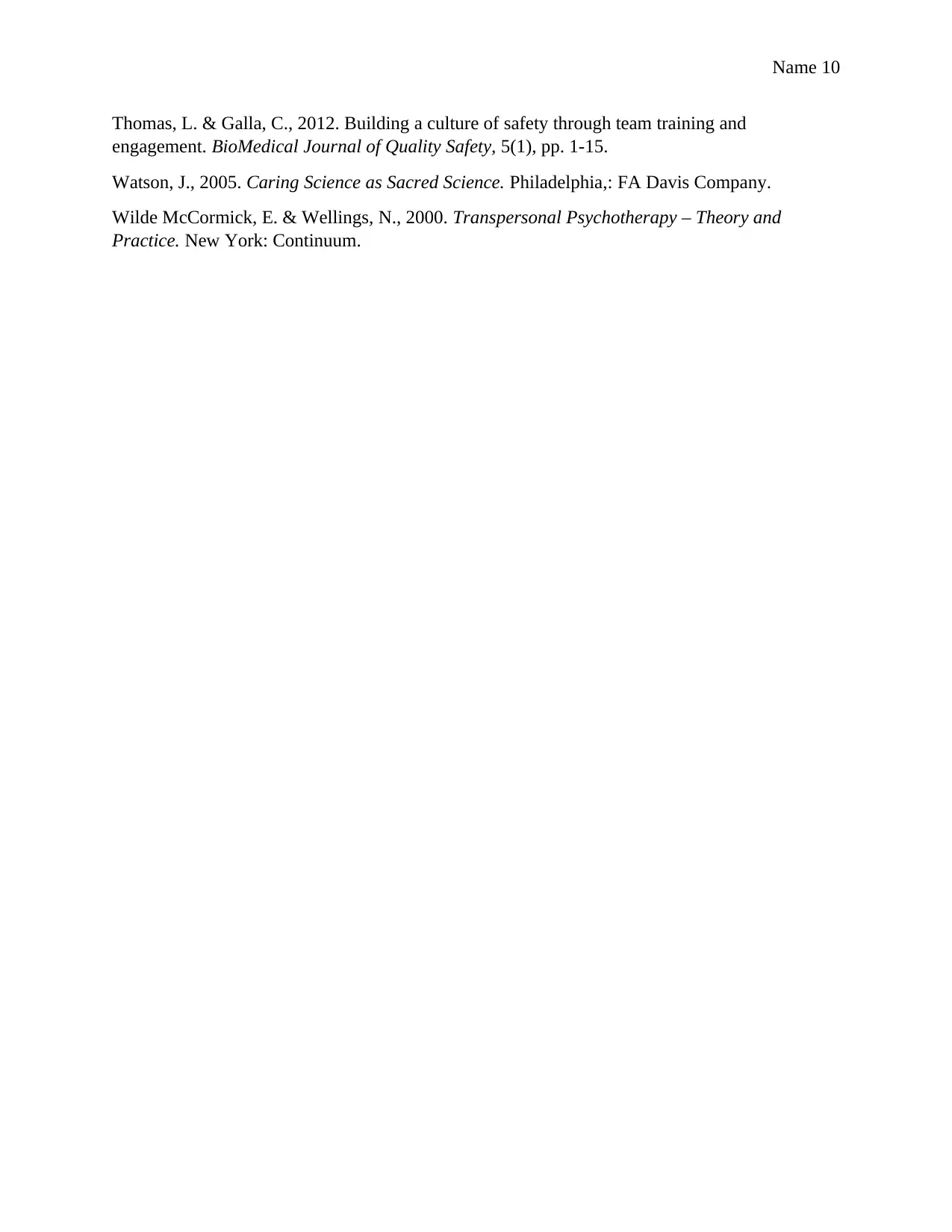
Name 10
Thomas, L. & Galla, C., 2012. Building a culture of safety through team training and
engagement. BioMedical Journal of Quality Safety, 5(1), pp. 1-15.
Watson, J., 2005. Caring Science as Sacred Science. Philadelphia,: FA Davis Company.
Wilde McCormick, E. & Wellings, N., 2000. Transpersonal Psychotherapy – Theory and
Practice. New York: Continuum.
Thomas, L. & Galla, C., 2012. Building a culture of safety through team training and
engagement. BioMedical Journal of Quality Safety, 5(1), pp. 1-15.
Watson, J., 2005. Caring Science as Sacred Science. Philadelphia,: FA Davis Company.
Wilde McCormick, E. & Wellings, N., 2000. Transpersonal Psychotherapy – Theory and
Practice. New York: Continuum.
1 out of 10
Related Documents
Your All-in-One AI-Powered Toolkit for Academic Success.
+13062052269
info@desklib.com
Available 24*7 on WhatsApp / Email
![[object Object]](/_next/static/media/star-bottom.7253800d.svg)
Unlock your academic potential
Copyright © 2020–2025 A2Z Services. All Rights Reserved. Developed and managed by ZUCOL.





